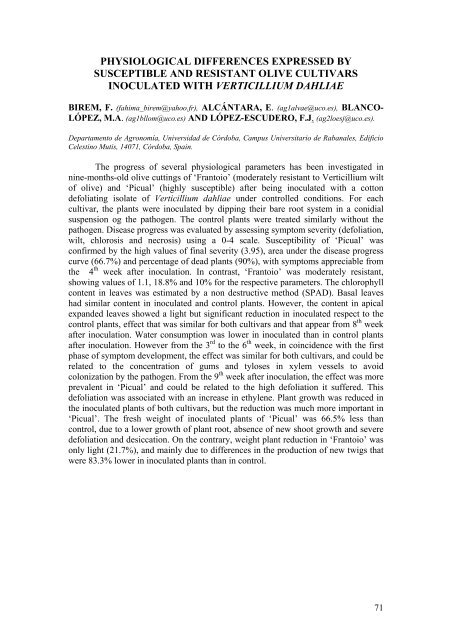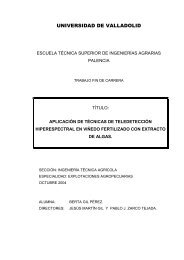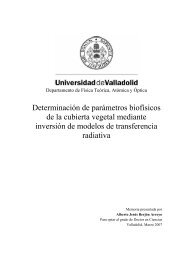10th INTERNATIONAL VERTICILLIUM SYMPOSIUM 16-20 ...
10th INTERNATIONAL VERTICILLIUM SYMPOSIUM 16-20 ...
10th INTERNATIONAL VERTICILLIUM SYMPOSIUM 16-20 ...
Create successful ePaper yourself
Turn your PDF publications into a flip-book with our unique Google optimized e-Paper software.
PHYSIOLOGICAL DIFFERENCES EXPRESSED BYSUSCEPTIBLE AND RESISTANT OLIVE CULTIVARSINOCULATED WITH <strong>VERTICILLIUM</strong> DAHLIAEBIREM, F. (fahima_birem@yahoo.fr), ALCÁNTARA, E. (ag1alvae@uco.es), BLANCO-LÓPEZ, M.A. (ag1bllom@uco.es) AND LÓPEZ-ESCUDERO, F.J. (ag2loesj@uco.es).Departamento de Agronomía, Universidad de Córdoba, Campus Universitario de Rabanales, EdificioCelestino Mutis, 14071, Córdoba, Spain.The progress of several physiological parameters has been investigated innine-months-old olive cuttings of ‘Frantoio’ (moderately resistant to Verticillium wiltof olive) and ‘Picual’ (highly susceptible) after being inoculated with a cottondefoliating isolate of Verticillium dahliae under controlled conditions. For eachcultivar, the plants were inoculated by dipping their bare root system in a conidialsuspension og the pathogen. The control plants were treated similarly without thepathogen. Disease progress was evaluated by assessing symptom severity (defoliation,wilt, chlorosis and necrosis) using a 0-4 scale. Susceptibility of ‘Picual’ wasconfirmed by the high values of final severity (3.95), area under the disease progresscurve (66.7%) and percentage of dead plants (90%), with symptoms appreciable fromthe 4 th week after inoculation. In contrast, ‘Frantoio’ was moderately resistant,showing values of 1.1, 18.8% and 10% for the respective parameters. The chlorophyllcontent in leaves was estimated by a non destructive method (SPAD). Basal leaveshad similar content in inoculated and control plants. However, the content in apicalexpanded leaves showed a light but significant reduction in inoculated respect to thecontrol plants, effect that was similar for both cultivars and that appear from 8 th weekafter inoculation. Water consumption was lower in inoculated than in control plantsafter inoculation. However from the 3 rd to the 6 th week, in coincidence with the firstphase of symptom development, the effect was similar for both cultivars, and could berelated to the concentration of gums and tyloses in xylem vessels to avoidcolonization by the pathogen. From the 9 th week after inoculation, the effect was moreprevalent in ‘Picual’ and could be related to the high defoliation it suffered. Thisdefoliation was associated with an increase in ethylene. Plant growth was reduced inthe inoculated plants of both cultivars, but the reduction was much more important in‘Picual’. The fresh weight of inoculated plants of ‘Picual’ was 66.5% less thancontrol, due to a lower growth of plant root, absence of new shoot growth and severedefoliation and desiccation. On the contrary, weight plant reduction in ‘Frantoio’ wasonly light (21.7%), and mainly due to differences in the production of new twigs thatwere 83.3% lower in inoculated plants than in control.71




